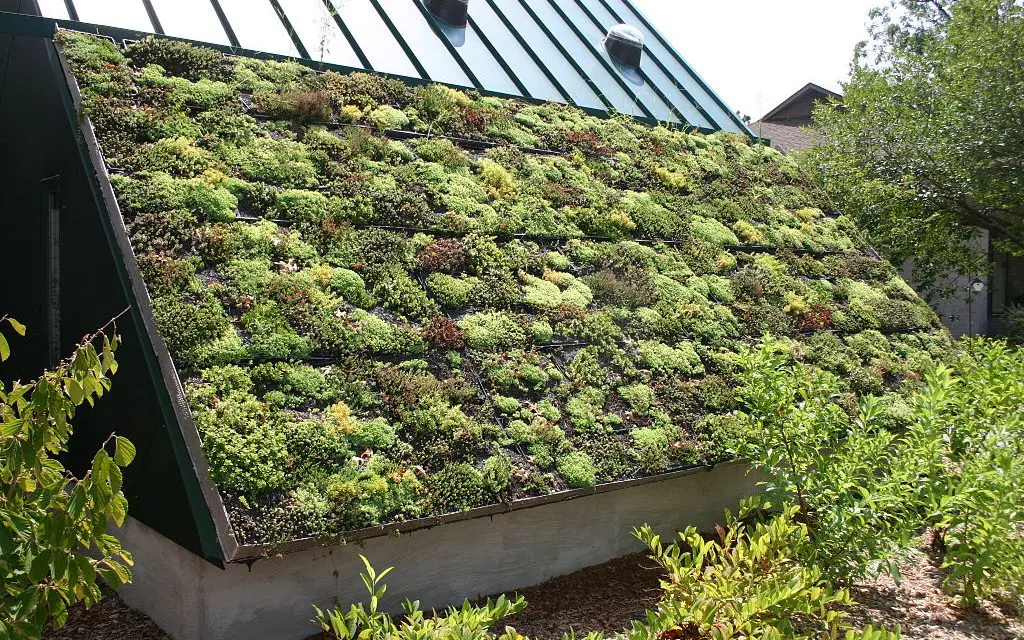“Green Roof”, Photo courtesy Ryan Somma, Licensed under CC BY-SA 2.0.
One of the most important decisions when building a green home is choosing a roof type. Because the energy efficiency of a home often comes down to heating and cooling, it is of utmost importance that a green home has the right roof to provide insulation rather than letting valuable hot or cold air escape. In addition, a roof that requires frequent maintenance and replacing will contribute negatively to the environment by adding waste to landfills.
Heat-reflecting recycled metal roofing, recycled roof tiles, and other green roof products are all great options for energy-efficient and earth-friendly roofing. But what if your roofing choice could be all that and more? Living green roofs are not just eco-friendly and energy-saving — they come with a huge abundance of benefits that other roof options simply can’t compete with. And unlike other roof options, planting a living green roof is something you can DIY-install on your own!
What is a living green roof?
The General Services Administration (GSA) has designed and maintained green roofs for decades, currently maintaining at least 24 green roofs in 13 cities around the country. Green roofs are defined by the GSA as vegetated roofs consisting of “a waterproofing membrane, growing medium (soil) and vegetation (plants) overlying a traditional roof.”
This roof system provides numerous eco-green perks. Green Roofs for Healthy Cities (GRHC) lists both public and private benefits to green roof installations: Public benefits of green roofs include neighborhood aesthetic appeal, better air quality, helping landfill diversion, and added stormwater management; while private benefits include energy efficiency, natural fire resistance, and durability.
Benefits to Planting a Living Green Roof
Durability
Properly installed green roofs more than double the number of years typically needed before a roof must be replaced when compared to traditionally-installed roofs. A conservative analysis by the GSA puts the average life expectancy of a living roof at about 40 years, as compared to an average expectancy of 17 for a conventional roof. GRHC adds that a green roof protects waterproofing membranes from temperature fluctuations and UV radiation, extending the life of the membrane.
Energy efficiency
A study published by the National Research Council of Canada showed that in the summer months, a green roof will reduce cool air loss by 70-90%, greatly reducing the demand for air conditioning. The GSA found similar efficiency figures, stating that green roofs can act as an insulating layer and reduce heat flux (transfer of heat through a building’s roof) by up to 72%. Using the Green Roof Energy Calculator, co-developed by GRHC with the University of Toronto and Portland State University, you can compare the yearly energy performance of your home as is to your home’s potential performance with a green roof installation.
Improved air quality
The plants living on green roofs, especially leafy plants and flowers, can capture air pollution and filter toxic gases from the air. The energy efficiency factor of green roofs also reduces demand for power, thereby decreasing the amount of CO2 being released into the atmosphere.
Noise reduction
Peck & Co’s analysis of green roof benefits showed that green living roofs have superb noise insulation, especially for low frequencies. Green roofs can reduce outside sound penetration by 40-60 decibels. Sounds like peace and quiet!
Property value increase
Increased efficiency means increase home value. In addition, green roofs are a marker of the popular green building movement. For this reason, a living roof can help with home sales, lease-outs, and lower tenant turnover.
Water retention
On a green roof, rainwater is retained in order to sustain the plants rather than flowing to storm sewers. Living roofs can retain 70-90% of precipitation in the summer and 24-40% in the winter. To put that into perspective, a green roof with anywhere from 2-8 inches of growth can hold 4-6 inches of water.
LEED credits
According to Green Roof Technology, installing a green roof can add as much as 15 LEED credits to your home, adding resale value in the future.
Curb appeal
A green roof means added biodiversity, aesthetic appeal, and more green space for relaxing, stress relief, and even gardening.
DIY Planting a Living Green Roof
Emmanuel from EcoHome.net shows the process he used to DIY install a living green roof at Edelweiss, the Eco-Home Demonstration home. As Emmanuel states, homes in both rural and urban areas can benefit from a living roof.
Emmanuel’s is a great example of the perfect roof for a DIY green-roof install — a low-pitched roof for safe walking without safety equipment. The roof features a stone perimeter which acts as an expansion joint for when the soil freezes in winter.
For more on DIY green roofs, check out our DIY Green Roof Guide.
For non-DIY green roof options, check out some featured green roof products:
Our team researches products, companies, studies, and techniques to bring the best of green building to you. Elemental Green does not independently verify the accuracy of all claims regarding featured products, manufacturers, or linked articles. Additionally, product and brand mentions on Elemental Green do not imply endorsement or sponsorship unless specified otherwise.



